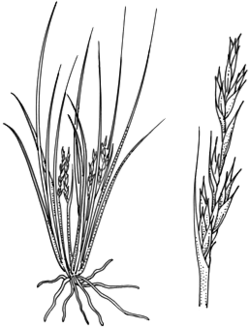Lepidosperma curtisiae K.L.Wilson & D.I.Morris APNI* 
Description: Small tufted perennial with very short rhizome.
Culms rigid, erect, ± convex on one face, flat on the other, ± striate, glabrous, smooth, 2–17(–25) cm high, 0.7–1.7 mm wide; margins minutely scabrous. Leaves similar in form to culms but usually more flattened and much longer (to twice as long as culms), 0.7–2.0(–2.5) mm wide; sheath straw-coloured above, dark brown at base, rarely reddish, not viscid, ± dull.
Inflorescence narrow-ovate to oblong in outline, erect, 1–3(–5) cm long, 0.5–1 cm diam.; involucral bract shorter to longer than inflorescence. Spikelets few, 4.5–6 mm long. Glumes 4–7, acute to long-acute, mostly mucronate, scaberulous, red-brown; 2 or 3 lowest empty, shorter than fertile glumes; fertile 4.0–5.5 mm long. Scales 6, about a third the length of nut, yellowish. Anthers 0.8–2.7 mm long, excluding appendage 0.2–0.5 mm long.
Nut ovoid to narrow-ellipsoid, 2.5–3.5 mm long, 1.3–1.5 mm diam., grey-green to dark brown, smooth, shining.
Flowering: spring–summer.
Distribution and occurrence: Often grows in exposed situations at higher altitudes, also in heath and woodland; (eastern edge of the tablelands).
NSW subdivisions: CC, SC, NT, CT, ST
Other Australian states: Vic. Tas. S.A.
Leaves are often twice as long as the culms in Vic. and Tas., but on the CC and CT they often only equal the culms. The style is rarely 4-fid.
Text by K. L. Wilson (1993); edited KL Wilson (Sept 2016)
Taxon concept: Flora of NSW 4 (1993)
APNI* Provides a link to the Australian Plant Name Index (hosted by the Australian National Botanic Gardens) for comprehensive bibliographic data
***The AVH map option provides a detailed interactive Australia wide distribution map drawn from collections held by all major Australian herbaria participating in the Australian Virtual Herbarium project.
|


